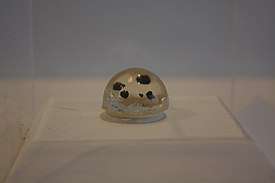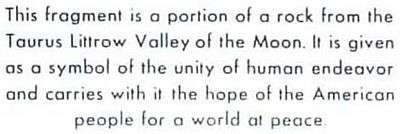New Jersey lunar sample displays
The New Jersey lunar sample displays are two commemorative plaques consisting of small fragments of Moon specimen brought back with the Apollo 11 and Apollo 17 lunar missions and given in the 1970s to the people of the state of New Jersey by United States President Richard Nixon.[1][2]

Description
Apollo 11
The New Jersey Apollo 11 lunar sample display commemorative podium style plaque consists of four "Moon rocks" rice-size particle specimens that were collected by Apollo 11 astronauts Neil Armstrong and Buzz Aldrin in 1969 and a small New Jersey state flag that was taken to the Moon and back.[1]
The four "Moon rocks" weigh about 0.05 grams total. They are encased in a clear plastic button the size of a coin and mounted to a wooden board approximately one foot square on a small podium pedestal display. The small podium plaque display also has mounted on it a small New Jersey state flag that had been to the Moon and back that lies directly below the "goodwill Moon rocks". The small podium plaque display was given to the people of the state of New Jersey as a gift by United States President Richard Nixon. Similar lunar sample displays were also distributed to all the other states of the United States and all the countries (at the time) of the world.[1] New Jersey was the last state to receive its Apollo 11 "goodwill Moon rock" commemorative display.[3]
Apollo 17

The New Jersey Apollo 17 lunar sample display commemorative style plaque, measuring 10 by 14 inches, consists of one "Moon rock" particle specimen that was cut from lunar basalt 70017 and a New Jersey state flag. The basalt 70017 was collected by Apollo 17 astronaut Harrison Schmitt on the Moon in 1972. Once lunar basalt 70017 was brought back to Earth from the Moon, the basalt Moon rock was cut up into small fragments of approximately 1 gram. The specimen was encased in a plastic ball and mounted on the wooden plaque along with the New Jersey state flag which had been taken to the Moon and back by the crew of Apollo 17. The plaque was then distributed in 1973 by President Richard Nixon to the state of New Jersey as he did that year to the other 49 states (the same as for the Apollo 11 plaque gifts). This was done as a goodwill gesture to promote peace and harmony.[2]
History
In March 1976 NASA astronaut Paul J. Weitz came to Trenton, New Jersey to personally present the New Jersey Apollo 17 commemorative plaque display with the 1 gram "goodwill Moon rock" to Environmental Protection Commissioner David Bard, Assemblyman Charles Yates, and Senator Anne Martindell on behalf of governor Brendan T. Byrne, who was in Arizona attending a conference. The 10 by 14 inch podium-style plaque display with the acrylic ball at the top portion had a small yellow New Jersey flag in the center that covered the plaque almost edge to edge widthwise. At the bottom of the display was a label that explained the 1 gram "goodwill Moon rock" was a fragment of a larger stone from the Taurus–Littrow lunar valley. The Governor's office requested that the display be placed on public showing soon thereafter. This order was never fulfilled.[3]
Weitz remarked later that he was recruited to help distribute the Apollo 17 commemorative plaque displays to their respective states. He pointed out the displays were not intended to remain in a governor's office like a trophy or tucked away in a drawer. The idea was to place them on public showing so everyone in the state could see them and enjoy them. But apparently, the Apollo 17 display with the "goodwill Moon rock" was mishandled by the New Jersey state bureaucracy and lost. As of 2012, nobody knows where it is.[3][4]
The Apollo 11 "goodwill Moon rocks" commemorative podium plaque display is currently housed at the New Jersey State Museum. David Parris, museum curator since 1971, is quoted as saying about the missing New Jersey Apollo 17 lunar sample display: "If it had come to the State Museum, I would surely know. I’ve been the principal geologist here since 1971".[5][upper-alpha 1]
Notes
- E-mail dated Thursday, September 13, 2012 1:28 PM from David C. Parris, Curator of Natural History, New Jersey State Museum: "The Dispatch article is exactly correct as written, Mr. Coldwell, including the quote from me. The moon rocks from Apollo 17 never came to the New Jersey State Museum, so of course we have no pictures nor news articles about them. To further reassure any observer, we discussed the matter with the State Police, who are equally satisfied that the specimen never came to the State Museum. I should point out that the rocks that we do have, from Apollo 11, were considered cultural entities at first, rather than Natural History items. They were registered by the Bureau of Cultural History, not Natural History, so they were registered by that Bureau. (The Apollo 17 moon rocks did not come to that Bureau either.) The Apollo 11 moon rocks are currently on exhibition in our exhibition NATURAL HISTORY HIGHLIGHTS."
References
- Pearlman, Robert. "Where today are the Apollo 11 goodwill lunar sample displays?". collectspace.com. Retrieved November 2, 2012.
- Pearlman, Robert (1999–2012). "Where today are the Apollo 17 goodwill lunar sample displays". collectspace.com. Retrieved November 2, 2012.
- "State Gets Its Own Pet Rock". The Trentonian. March 20, 1976. p. 19.
- "Lost in Trenton". The Record. Trenton, New Jersey. May 20, 2010. Retrieved November 4, 2012.
- Young, Elise (May 19, 2010). "Trenton, we have a problem: NJ's souvenir moon rock missing since 1970s". The Record. Trenton, New Jersey. Retrieved November 4, 2012.
Further reading
- Kloc, Joe (February 19, 2012). The Case of the Missing Moon Rocks. The Atavist/Amazon Digital Services, Inc. p. 47. ASIN B007BGZNZ8.
External links
| Wikimedia Commons has media related to New Jersey lunar sample display. |




